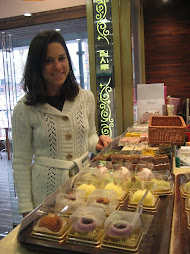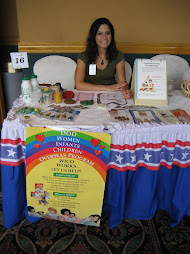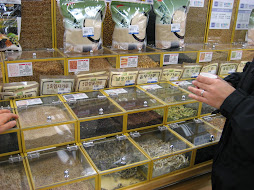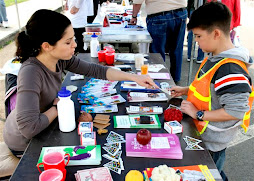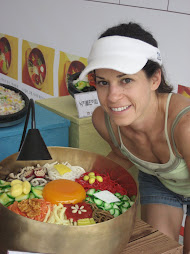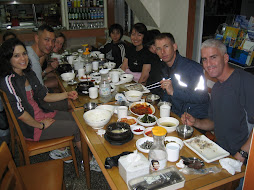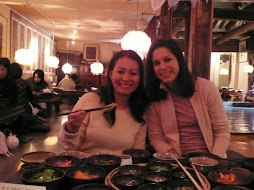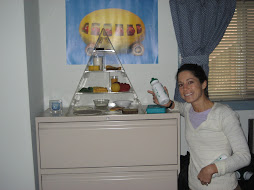 I loved the water machines with the paper cup dispensers:
I loved the water machines with the paper cup dispensers:Tuesday, February 17, 2009
Water Fountain at National Palace Museum
This week we perused the National Palace Museum for our Sunday afternoon activity. It contained documents and other items from the royal family. As you can see, we were among the few people there: I loved the water machines with the paper cup dispensers:
I loved the water machines with the paper cup dispensers:
 I loved the water machines with the paper cup dispensers:
I loved the water machines with the paper cup dispensers:Sunday, February 15, 2009
Valentine's Day Chocolates
In Korea women give men chocolate for Valentine's Day. We watched the ritual several times while enjoying red drinks at the Seoul Hyatt. Our friend gave us chocolates too: One month later, on White Day, men return the gesture by giving candy to women.
One month later, on White Day, men return the gesture by giving candy to women. I guess my self-made holiday, Analog Holiday, is not really unique after all. On this day I treat my husband to his favorite "man" things. We celebrate it on January 14, one month before V-day. I'm not sure if he likes it as much as I like V-day!
I guess my self-made holiday, Analog Holiday, is not really unique after all. On this day I treat my husband to his favorite "man" things. We celebrate it on January 14, one month before V-day. I'm not sure if he likes it as much as I like V-day!
 One month later, on White Day, men return the gesture by giving candy to women.
One month later, on White Day, men return the gesture by giving candy to women. I guess my self-made holiday, Analog Holiday, is not really unique after all. On this day I treat my husband to his favorite "man" things. We celebrate it on January 14, one month before V-day. I'm not sure if he likes it as much as I like V-day!
I guess my self-made holiday, Analog Holiday, is not really unique after all. On this day I treat my husband to his favorite "man" things. We celebrate it on January 14, one month before V-day. I'm not sure if he likes it as much as I like V-day!
Saturday, February 14, 2009
Pancakes and Pizza
My friend Angella and I have started cooking together. She brings ingredients to prepare a Korean food, and I prepare something American. Last night we made pizza and Korean pancakes. I made the whole wheat crust in advance. Here we are chopping food for our recipes: Angella purchased a ready-made Korean pancake mix, pre-peeled onions, zuchini, and leaves:
Angella purchased a ready-made Korean pancake mix, pre-peeled onions, zuchini, and leaves:
 You can make the Korean pancake with any vegetable or seafood. Here is the mix:
You can make the Korean pancake with any vegetable or seafood. Here is the mix:
 Angella created her own pizza for the first time. I showed her how to flatten the dough and add the accoutrements. We always eat BBQ chicken and pineapple pizza, but sometimes I throw old leftovers on the top.
Angella created her own pizza for the first time. I showed her how to flatten the dough and add the accoutrements. We always eat BBQ chicken and pineapple pizza, but sometimes I throw old leftovers on the top.
 Angella taught me how to fry and flip the Korean pancake. We did not have the right ladle, spatula, or frying pan in our American kitchen. She managed fine, though. We made a simple dipping sauce of sesame oil and low-sodium soy sauce. Since we only had two pairs of chopsticks, I used a fork with mine. It felt really strange; Korean pancakes are meant to be eaten with chopsticks. Angella taught Eric how to cut the pancake with the chopstick. I used the pizza cutter on mine.
Angella taught me how to fry and flip the Korean pancake. We did not have the right ladle, spatula, or frying pan in our American kitchen. She managed fine, though. We made a simple dipping sauce of sesame oil and low-sodium soy sauce. Since we only had two pairs of chopsticks, I used a fork with mine. It felt really strange; Korean pancakes are meant to be eaten with chopsticks. Angella taught Eric how to cut the pancake with the chopstick. I used the pizza cutter on mine.
 Angella purchased a ready-made Korean pancake mix, pre-peeled onions, zuchini, and leaves:
Angella purchased a ready-made Korean pancake mix, pre-peeled onions, zuchini, and leaves: You can make the Korean pancake with any vegetable or seafood. Here is the mix:
You can make the Korean pancake with any vegetable or seafood. Here is the mix: Angella created her own pizza for the first time. I showed her how to flatten the dough and add the accoutrements. We always eat BBQ chicken and pineapple pizza, but sometimes I throw old leftovers on the top.
Angella created her own pizza for the first time. I showed her how to flatten the dough and add the accoutrements. We always eat BBQ chicken and pineapple pizza, but sometimes I throw old leftovers on the top.  Angella taught me how to fry and flip the Korean pancake. We did not have the right ladle, spatula, or frying pan in our American kitchen. She managed fine, though. We made a simple dipping sauce of sesame oil and low-sodium soy sauce. Since we only had two pairs of chopsticks, I used a fork with mine. It felt really strange; Korean pancakes are meant to be eaten with chopsticks. Angella taught Eric how to cut the pancake with the chopstick. I used the pizza cutter on mine.
Angella taught me how to fry and flip the Korean pancake. We did not have the right ladle, spatula, or frying pan in our American kitchen. She managed fine, though. We made a simple dipping sauce of sesame oil and low-sodium soy sauce. Since we only had two pairs of chopsticks, I used a fork with mine. It felt really strange; Korean pancakes are meant to be eaten with chopsticks. Angella taught Eric how to cut the pancake with the chopstick. I used the pizza cutter on mine.Now I feel confident enough to make the pancakes myelf, probably from scratch. I don't know if Angella will attempt the pizza. Good mozzarella cheese and pizza sauce are difficult finds here. Next time we're going to bake sweets!
Tuesday, February 10, 2009
Baby Formula Bonanza
I explored the baby food aisle to compare products to those I issue through the WIC program. WIC provides jarred baby foods; Emart did not carry them. I think many Korean parents make baby food by themselves. I know that they serve mashed rice to their babies at six months.
Formula was plentiful and expensive. Emart uses security devices on its formulas:
 I had never seen locked formulas before, though I had heard of such security measures in low-income areas.
I had never seen locked formulas before, though I had heard of such security measures in low-income areas.
WIC provides cow's milk- or soy-based formula. Emart carried goat's milk formula:
 Goat's milk formula is supposedly more easily digestible and less allergenic. Allergic babies should only take goat's milk formula if approved by a doctor. It would be very difficult, if not impossible, to find in the United States. Parents use soy or special hypoallergenic formulas
Goat's milk formula is supposedly more easily digestible and less allergenic. Allergic babies should only take goat's milk formula if approved by a doctor. It would be very difficult, if not impossible, to find in the United States. Parents use soy or special hypoallergenic formulas
I was tempted to buy this one for myself. Why not? My friend bought the colostrum for herself!
Formula was plentiful and expensive. Emart uses security devices on its formulas:
 I had never seen locked formulas before, though I had heard of such security measures in low-income areas.
I had never seen locked formulas before, though I had heard of such security measures in low-income areas.WIC provides cow's milk- or soy-based formula. Emart carried goat's milk formula:
 Goat's milk formula is supposedly more easily digestible and less allergenic. Allergic babies should only take goat's milk formula if approved by a doctor. It would be very difficult, if not impossible, to find in the United States. Parents use soy or special hypoallergenic formulas
Goat's milk formula is supposedly more easily digestible and less allergenic. Allergic babies should only take goat's milk formula if approved by a doctor. It would be very difficult, if not impossible, to find in the United States. Parents use soy or special hypoallergenic formulas for babies with milk allergy. Another unique product was colostrum:
Another unique product was colostrum:
 A mother produces colostrum the first week or so after giving birth. It contains more protein, salt, and antibodies than regular breastmilk. It also has less fat and fewer calories. Colostrum is one benefit of breastfeeding; bottle-fed babies don't receive it, at least not in the United States. I've seen colostrum at supplement stores (body builder's milk) but never in the baby aisle.
A mother produces colostrum the first week or so after giving birth. It contains more protein, salt, and antibodies than regular breastmilk. It also has less fat and fewer calories. Colostrum is one benefit of breastfeeding; bottle-fed babies don't receive it, at least not in the United States. I've seen colostrum at supplement stores (body builder's milk) but never in the baby aisle.
 Another unique product was colostrum:
Another unique product was colostrum: A mother produces colostrum the first week or so after giving birth. It contains more protein, salt, and antibodies than regular breastmilk. It also has less fat and fewer calories. Colostrum is one benefit of breastfeeding; bottle-fed babies don't receive it, at least not in the United States. I've seen colostrum at supplement stores (body builder's milk) but never in the baby aisle.
A mother produces colostrum the first week or so after giving birth. It contains more protein, salt, and antibodies than regular breastmilk. It also has less fat and fewer calories. Colostrum is one benefit of breastfeeding; bottle-fed babies don't receive it, at least not in the United States. I've seen colostrum at supplement stores (body builder's milk) but never in the baby aisle. A mixed vegetable powdered "formula":
I was tempted to buy this one for myself. Why not? My friend bought the colostrum for herself!
Sunday, February 8, 2009
Daeborum - Full Moon Foods
Yesterday was daeborum, the first full moon of the lunar new year. On this day, Koreans eat certain foods for health and vitality. Traditionally the foods provided the vitality that farmers needed for the farming season to come. I tagged along while a friend shopped for the foods at Emart. Here are the foods she bought:
Rice cakes (upper lefthand corner) made with rice, fruits, and chestnuts:
 Vegetables (naemul) and rice (a mix of several types and red bean). The red bean gives the rice a reddish-brown color. Here are the pre-made options:
Vegetables (naemul) and rice (a mix of several types and red bean). The red bean gives the rice a reddish-brown color. Here are the pre-made options:
Rice cakes (upper lefthand corner) made with rice, fruits, and chestnuts:
 Vegetables (naemul) and rice (a mix of several types and red bean). The red bean gives the rice a reddish-brown color. Here are the pre-made options:
Vegetables (naemul) and rice (a mix of several types and red bean). The red bean gives the rice a reddish-brown color. Here are the pre-made options:A Fruit Cart in Itaewon
Saturday, February 7, 2009
Puffed Rice Cakes - A Stigmatized Food?
Rice cakes are a stigmatized food in the U.S. They're the food a dieter forces herself to eat as a "healthy replacement" for chips or cookies. In Korea rice cakes seem to be a popular snack food. Street vendors sell them. You can hear the characteristic "thwack!" as a new rice cake pops out of the machine. E-mart sells them too: Surprisingly, no one is sampling the rice cakes. Usually you'll find several aggressive older Korean ladies huddled around a sample plate. Sometimes it seems they are eating a meal, not sampling.
Surprisingly, no one is sampling the rice cakes. Usually you'll find several aggressive older Korean ladies huddled around a sample plate. Sometimes it seems they are eating a meal, not sampling.
Anyway, you can find plenty of variations, from grain type to size:
 Surprisingly, no one is sampling the rice cakes. Usually you'll find several aggressive older Korean ladies huddled around a sample plate. Sometimes it seems they are eating a meal, not sampling.
Surprisingly, no one is sampling the rice cakes. Usually you'll find several aggressive older Korean ladies huddled around a sample plate. Sometimes it seems they are eating a meal, not sampling.Anyway, you can find plenty of variations, from grain type to size:
Friday, February 6, 2009
Not the Jack-o-Lantern
When I can't go to Lotte Department Store food court for my favorite hobak juk, I eat the boxed version. Here I am stocking up on porridges at E-mart: I had always assumed that pumpkin (the Halloween decoration on American front porches) was the primary ingredient, as indicated by the name.
I had always assumed that pumpkin (the Halloween decoration on American front porches) was the primary ingredient, as indicated by the name.  I guess I never noticed the small green squash on the lower right hand corner of the box!
I guess I never noticed the small green squash on the lower right hand corner of the box! It turns out that pumpkin refers to kabocha squash. According to Wikipedia, kabocha goes by "Japanese pumpkin" in Southeast Asia and "kabocha squash" in North America. Over 90% of American-grown kabocha is exported to Asia. I can see why - it's the main ingredient for a variety of products.
It turns out that pumpkin refers to kabocha squash. According to Wikipedia, kabocha goes by "Japanese pumpkin" in Southeast Asia and "kabocha squash" in North America. Over 90% of American-grown kabocha is exported to Asia. I can see why - it's the main ingredient for a variety of products.
 I had always assumed that pumpkin (the Halloween decoration on American front porches) was the primary ingredient, as indicated by the name.
I had always assumed that pumpkin (the Halloween decoration on American front porches) was the primary ingredient, as indicated by the name.  I guess I never noticed the small green squash on the lower right hand corner of the box!
I guess I never noticed the small green squash on the lower right hand corner of the box! It turns out that pumpkin refers to kabocha squash. According to Wikipedia, kabocha goes by "Japanese pumpkin" in Southeast Asia and "kabocha squash" in North America. Over 90% of American-grown kabocha is exported to Asia. I can see why - it's the main ingredient for a variety of products.
It turns out that pumpkin refers to kabocha squash. According to Wikipedia, kabocha goes by "Japanese pumpkin" in Southeast Asia and "kabocha squash" in North America. Over 90% of American-grown kabocha is exported to Asia. I can see why - it's the main ingredient for a variety of products.Candy:  A dish resembling potato salad:
A dish resembling potato salad: Rice cake filling:
Rice cake filling: Here is the kabocha squash in its natural state. Though low in calories, it can be filling. It's a great source of fiber and beta carotene.
Here is the kabocha squash in its natural state. Though low in calories, it can be filling. It's a great source of fiber and beta carotene. Cutting and peeling can be difficult. E-mart sells them stripped-and-skinned:
Cutting and peeling can be difficult. E-mart sells them stripped-and-skinned: I cut it in half and bake it at 385F for 30 minutes. Then I eat slices of it plain for a snack. The peel is edible.
I cut it in half and bake it at 385F for 30 minutes. Then I eat slices of it plain for a snack. The peel is edible.
 Discovering the kabocha opened a new world of vegetables: the squashes. They're so nutritious and easy to prepare. They can sit for weeks until you have the motivation to eat a vegetable!
Discovering the kabocha opened a new world of vegetables: the squashes. They're so nutritious and easy to prepare. They can sit for weeks until you have the motivation to eat a vegetable!
 A dish resembling potato salad:
A dish resembling potato salad: Rice cake filling:
Rice cake filling: Here is the kabocha squash in its natural state. Though low in calories, it can be filling. It's a great source of fiber and beta carotene.
Here is the kabocha squash in its natural state. Though low in calories, it can be filling. It's a great source of fiber and beta carotene. Cutting and peeling can be difficult. E-mart sells them stripped-and-skinned:
Cutting and peeling can be difficult. E-mart sells them stripped-and-skinned: I cut it in half and bake it at 385F for 30 minutes. Then I eat slices of it plain for a snack. The peel is edible.
I cut it in half and bake it at 385F for 30 minutes. Then I eat slices of it plain for a snack. The peel is edible. Discovering the kabocha opened a new world of vegetables: the squashes. They're so nutritious and easy to prepare. They can sit for weeks until you have the motivation to eat a vegetable!
Discovering the kabocha opened a new world of vegetables: the squashes. They're so nutritious and easy to prepare. They can sit for weeks until you have the motivation to eat a vegetable!Monday, February 2, 2009
Korean Women & Infant Nutrition Practices
I discuss nutrition with Korean families on a daily basis. I try to be culturally sensitive because some Korean practices differ greatly from American ones. Here are a few examples based on my experience, not research:
-In Korea bottlefeeding until 18 months is the norm. After 18 months the baby transitions to specialized "baby milk." Some Korean mothers are shocked when I say their baby can drink "adult milk" at 12 months.
-Some Korean parents want to feed their children American foods. They think the child will be bigger that way.
-Koreans do not like the baby to go outside until 100 days after birth. Some parents are irritated when they have to bring their newborns here.
-Babies drink rice or barley water at age three months or younger. If the baby wakes up at night, the mother feeds the baby rice water. (Rice or barley water is the water remaining after grain preparation. This water offers minimal, if any, nutrition. The barley water might have some B vitamins.) According to the American Academy of Pediatrics, formula or breastmilk provides enough fluid until a baby starts eating. Only in certain circumstances would a baby need water otherwise.
-Formula is more expensive in Korea than in the United States.
-A new mother follows a special post-pregnancy diet. It forbids certain foods, such as kimchi'i, and includes seaweed soup. This diet supposedly encourages breast milk production. The military hospital used to offer seaweed soup to new mothers. Breastfed babies can become colicky when their mothers eat gas-forming foods such as cabbage. Eliminating kimchi'i makes sense, though I imagine that the mother only does so temporarily. -In the past, Korean women tried to gain as much weight as possible during pregnancy. Some women would gain 100 pounds! This practice has changed, though. A weight gain of 25-35 pounds is plenty for a woman of normal BMI.
-In the past, Korean women tried to gain as much weight as possible during pregnancy. Some women would gain 100 pounds! This practice has changed, though. A weight gain of 25-35 pounds is plenty for a woman of normal BMI.
-In Korea bottlefeeding until 18 months is the norm. After 18 months the baby transitions to specialized "baby milk." Some Korean mothers are shocked when I say their baby can drink "adult milk" at 12 months.
-Some Korean parents want to feed their children American foods. They think the child will be bigger that way.
-Koreans do not like the baby to go outside until 100 days after birth. Some parents are irritated when they have to bring their newborns here.
-Babies drink rice or barley water at age three months or younger. If the baby wakes up at night, the mother feeds the baby rice water. (Rice or barley water is the water remaining after grain preparation. This water offers minimal, if any, nutrition. The barley water might have some B vitamins.) According to the American Academy of Pediatrics, formula or breastmilk provides enough fluid until a baby starts eating. Only in certain circumstances would a baby need water otherwise.
-Formula is more expensive in Korea than in the United States.
-A new mother follows a special post-pregnancy diet. It forbids certain foods, such as kimchi'i, and includes seaweed soup. This diet supposedly encourages breast milk production. The military hospital used to offer seaweed soup to new mothers. Breastfed babies can become colicky when their mothers eat gas-forming foods such as cabbage. Eliminating kimchi'i makes sense, though I imagine that the mother only does so temporarily.
 -In the past, Korean women tried to gain as much weight as possible during pregnancy. Some women would gain 100 pounds! This practice has changed, though. A weight gain of 25-35 pounds is plenty for a woman of normal BMI.
-In the past, Korean women tried to gain as much weight as possible during pregnancy. Some women would gain 100 pounds! This practice has changed, though. A weight gain of 25-35 pounds is plenty for a woman of normal BMI.
Subscribe to:
Comments (Atom)










